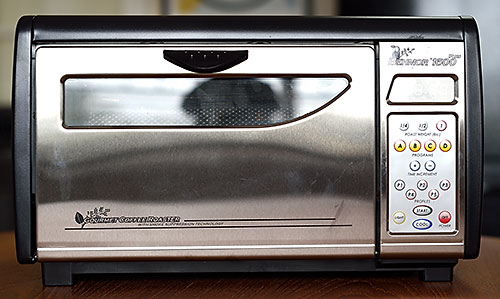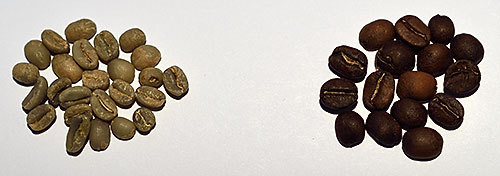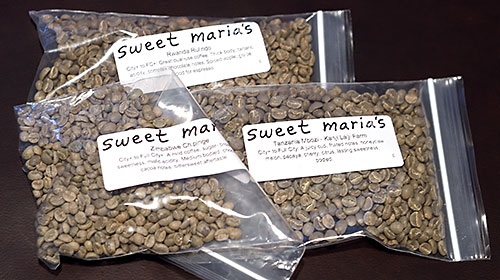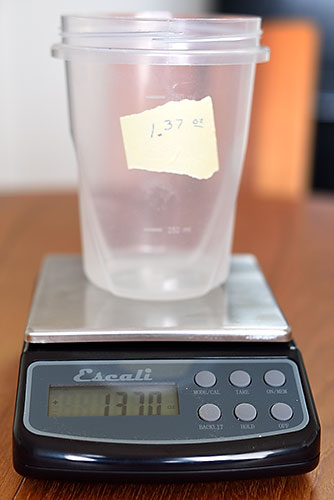No, the contraption shown below is not a toaster oven. You can even watch the inventor shudder online when told that his pride and joy resembles one. It’s a Behmor home coffee roaster, and is photographed atop my kitchen table ’cause it belongs to me. I have stunk up the garage with fumes from about fifteen roasts now, am fascinated enough by my new hobby to want to drone about it here.

This is a personal blog. I don’t have advertisers, don’t want any, write about whatever weirdsville subject catches my fancy.
Today, it’s home coffee roasting.
* * * * *
Question #1: What is it?
The occasionally smoky and always odoriferous cooking up of raw green coffee beans.
At left, below: some Ethiopia Agaro beans, fetched from a one pound bag sold by Sweet Maria’s coffee warehouse in West Oakland. Green little buggers, aren’t they? You wouldn’t try to put these guys in a coffee grinder, would you? No! They’re green. Raw. Unready.
Few markets sell green coffee beans. Home roasters buy from Sweet Maria’s or other specialty suppliers.
At right: a roast of Guatemala Finca Candeleria Bourboncito after a cruise in the Behmor.

Brown. Cooked. (If only you could smell them a day after the roast, you unlucky instant drinker, you!) Ready for the burr grinder.
Question #2: Why bother?
In coffee, freshness counts. A lot. The unroasted green beans can slumber contentedly for eons, but the browned, cooked bean retains full flavor for a matter of days.
DAYS, folks. Cognoscenti differ on how many. I have tasted a difference after only three.
The majors can angle for first dibs on crops, hire PhDs to craft roast curves, cook up beans on gazillion dollar hardware. They still can’t economically supply consumers with genuinely fresh roasted coffee beans. I don’t care how much they pay TruthStretchers Inc. to lean on a Fresh! Fresh! Fresh! theme in an ad campaign. The roast date won’t be on the package, or will be printed in an eeny-weeny-teeny coded cipher that Betty BeanBuyer won’t see or understand. That bag of whole beans that Betty sticks in her cart might be months old.
The home roaster bets that his genuinely fresh roasted beans will mop the floor with hopelessly stale commercial beans, PhDs and gazillion dollar hardware notwithstanding.
Question #3: Is there a catch?
There are several.
- The biggest: Smoke and smell. The Behmor advertises ‘smoke suppression technology,’ but still stinks plenty, and sometimes emits smoke. I expect my garage to reek for twelve hours after a roast, and would never use a home roaster in an apartment or condo.

- Time and trouble. I need a half hour to roast eight ounces, counting set-up, cool down, clean-up. That’s a serious investment of tickety-tock for a wage earner hankering after a drinkable shot of morning caffeine. It’s no accident that I took up this hobby in retirement.
- Potential danger. Over-roasted beans can catch fire.
Question #4: How’s it done?
- Acquire raw coffee beans.
- Apply heat. A drum roaster applies heat evenly, but beans can be roasted in frying pans, in popcorn poppers, with heat guns in dog bowls, in jerry-rigged backyard barbecue add ons. (And fires can be started while doing so. I am providing an overview, not instructions.)
- Wait. The beans shall brown, warm, remain unready for some minutes, depending on batch size.
- Listen. Eventually the beans will emit a sharp cracking sound, a bit like popping popcorn. First there will be one, two or three cracks; soon there will be many. “First crack” is underway. The roaster is paying excruciatingly close attention now, and is ready to end the roast at any time, depending on taste.
- Listen II: The beans may be quiet for awhile after first crack ends.

- Listen III: Eventually the lighter, faster, quieter poppety-pop of ‘second crack’ may be heard. Most end a home roast at this point, unless after a dark Vienna or darker-still French roast.
(Roasters use the terms City, City+, Full City and Full City+ to describe roast levels before Vienna. No idea why.)
Question #5: Does it matter?
I wonder. Aficionados rate Ethiopia, Kenya, and Guatemala among the world’s best coffee growing regions. These countries are dirt poor. As a veteran of a 501(c)3, I am much smitten by the idea of voluntary wealth transfers from consumers with discretionary dollars to spend to poor providers with something desirable to sell. Maybe I’m out to lunch. I don’t know the industry, might be barking up the wrong coffee shrub.
Gene Cafe and Hottop compete with Behmor in the home roaster market. To my knowledge, all home roasters emit smell and smoke, require careful monitoring. What if someone invents a home roasting Model T, a set-and-forget that doesn’t stink? Those superb cups of java I now take for granted would be within reach of apartment-dwelling 9-to-5ers.
* * * * *
Update, 6/16: ‘Garages’ are what most little San Francisco row houses have. Not basements. I fixed the mistake in the first paragraph.
And while I’m at it: this post is intended for those interested in the taste of straight black coffee. I reach immediately for sugar and lightener when consuming stale pre-ground hotel coffee on the road, but wouldn’t dream of using either with a home roast. If your tastes run to sweet, flavored coffees, I’d feel safe in writing off home roasting as a waste of time.
So much good information and insight to build upon if especially if you’re in the beginning of your roasting journey. Great instruction, Lauren and Derek were very chill and personable as well.